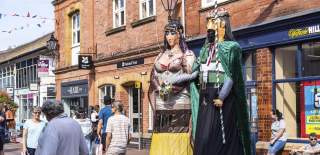History & Culture
Sidmouth is a town with a rich history and a fascinating culture which stems from its time as being a favourite among Victorian and Georgian families.
A varied timeline
Sidmouth has been a community for hundreds of years, it appears in the Domesday Book, which was published in 1086 under the name of Sedemuda, which translates as Mouth of the Sid, with the name coming from the River Sid which runs through the town and into the Sid Valley. It was listed as being a fishing village, like many of the settlements along the Devon coast.
Historical accounts show that Sidmouth remained a village until the 18th century, when visiting the coastal resorts of the South West became fashionable during the Georgian and Victorian periods, you can see evidence of this in the number of Georgian and Regency style buildings that still remain. Along the Esplanade, you can see several buildings which are now hotels that were built in this era. While much of the South West was fashionable in Regency society, Sidmouth is special because of its Royal connections. In 1819, Edward, Duke of Kent, the son of George III, took a family holiday in the town, bringing his baby daughter, who went on to become Queen Victoria to stay at Woolbrook Glen.
Woolbrook Glen is now the Royal Glen Hotel – look out for the plaque marking their visit outside!
During the time that Sidmouth’s popularity grew, it was connected to the railway network in the 1870s with routes to Ottery St Mary but was dismantled in the 1960s. Not much of the railway line and tunnels remains, but there are a few traces that can be found around the town and through the Sid Valley – have you spotted them?
Sidmouth’s town museum is a haven for anyone wanting to find out more about the town’s history – covering the town’s heritage, the geological history of the Jurassic Coast and regular events, ideal whatever your age or prior knowledge. You can also learn more about the town on your own by following the Blue Plaques on Sidmouth’s heritage walk. Maps and routes can be picked up from the Tourist Information Centre.
A town full of culture
When it comes to showing visitors a good time, Sidmouth is up there with the best of them. The town’s Regency feel gives off a grand atmosphere which, combined with the extensive event calendar makes it a real cultural hub. There are regular performances at the Manor Pavilion arts centre and theatre, which is also home to the Radway Cinema. In the summer months, Sidmouth Town Band play a series of concerts in the Connaught Gardens every Sunday in the heritage band stand.
Like most of Devon, Sidmouth has a host of famous literary connections, including JRR Tolkien who had a holiday home in the town and is said to have written part of Lord of the Rings there and poet Elizabeth Barrett lived in the town for a number of years. It even appeared in several novels under different names like Beatrix Potter’s The Tale of Little Pig Robinson and Thomas Hardy’s Wessex.
This is one of the reasons why it is such a popular spot for bibliophiles who flock to the town during the annual literary festival.
Other festivals that take place regularly include the Sidmouth Folk Festival which takes place over a week in early August offering performances, workshops and children’s activities. You can also take part in a science festival, walking festival, the annual classic car show and the famous Sidmouth Regatta.

